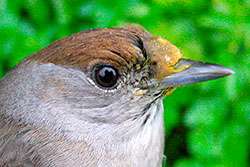Pollen on birds shows feeding grounds

Encrusted pollen on migrating birds' heads can shed light on where they've taken a break from migration to refuel, scientists say.
They found that many of the warblers trapped and ringed at Portland Bill in Dorset carry traces of pollen from the eucalyptus and citrus plantations of Spain and Portugal – a food source that hasn't been there until recently.
The findings may help protect threatened songbirds; they suggest that commercial and garden tree species may be more important as a food source for migrating birds than previously suspected. Many of these birds are already under pressure from changes in the climate and in the habitats they need to feed and reproduce; we might be able help more of them survive migration by planting the right species along the way.
The warblers arrive in the UK after spending winter in the Mediterranean and north Africa. If all goes well they can make it here in a single hop, but if the weather turns bad or they haven't manage to stockpile enough energy in advance they may have to stop and find food along the way. As they forage for nectar and insects, they get pollen grains stuck to their plumage.
'We think some of the birds that are stopping off to feed in Iberia may be migrating sub-optimally, whether because they haven't managed to find enough food ahead of migration or just because of bad weather,' says Dr Matt Wood of the University of Gloucestershire, lead author of the paper in Bird Study. 'So these are birds that might not make it to Britain if this food source wasn't available to them. People don't always think of these landscapes as valuable for conservation, but our results suggest perhaps they are.'
Pollen analysis is widely used in disciplines like archaeology and forensic science. Researchers have tried to use it before to understand what birds have been eating on the way to Britain, but never on such a large scale. The researchers behind this study examined 113 individuals from four warbler species chiffchaffs, willow warblers, blackcaps and garden warblers – by clipping small feathers from around their beaks and examining the pollen stuck to them under a microscope. In all, 19 kinds of pollen were present – mostly from eucalyptus and citrus, but also from other trees including pines and maples.
Not all the birds were carrying significant amounts of pollen, but those that did tended to have a distinctive mix of pollen types depending on their species – probably due to differences in foraging behaviour.
The researchers were initially hoping the pollen analysis might reveal longer-term information about where in Africa the birds had been spending winter. Despite decades of putting identifying rings on millions of birds in the UK and elsewhere, we still have very little idea about where many songbirds spend the winter – remarkably, only a handful of willow warblers breeding in the UK have ever been recovered on their wintering grounds in central west Africa.
As things turned out the pollen didn't provide this information – it seems to come from feeding stopoffs on the way back to the UK, rather than from the places in Africa where the warblers spent winter.
Wood says that much more detailed maps of which species grows where in Africa would increase the chance that pollen analysis could provide this sort of information, but that we shouldn't hope for too much information – the technique is probably better suited to revealing birds' foraging tactics and food preferences than their overwintering sites.
'Our technique has quite low geographical resolution, but it points towards a way we can start to find answers to the big questions about where these birds are spending the winter,' Wood says, explaining that warblers are too small to carry radio trackers so pollen analysis is one of the few methods available to scientists.
He adds that he'd like to do more analysis of the 'clean' birds that weren't laden with facial pollen. These birds will still carry traces of pollen around their bodies even though they haven't been foraging among flowers like their peers; comparing these traces with the facial pollen could provide longer-term information about where the birds have been over the winter.
More information: "Exploring the prevalence and diversity of pollen carried by four species of migratory Old World warbler (Sylvioidea) on arrival in the UK." Matt J. Wood, Peter J. Morgan, Julia C. Webb, Anne E. Goodenough, Frank M. Chambers & Adam G. Hart. Bird Study, Volume 61, Issue 3, 2014. DOI: 10.1080/00063657.2014.938017.
Provided by PlanetEarth Online
This story is republished courtesy of Planet Earth online, a free, companion website to the award-winning magazine Planet Earth published and funded by the Natural Environment Research Council (NERC).
















